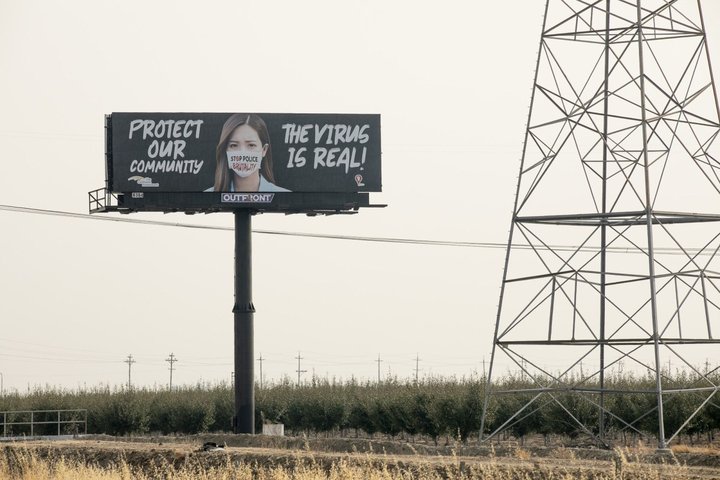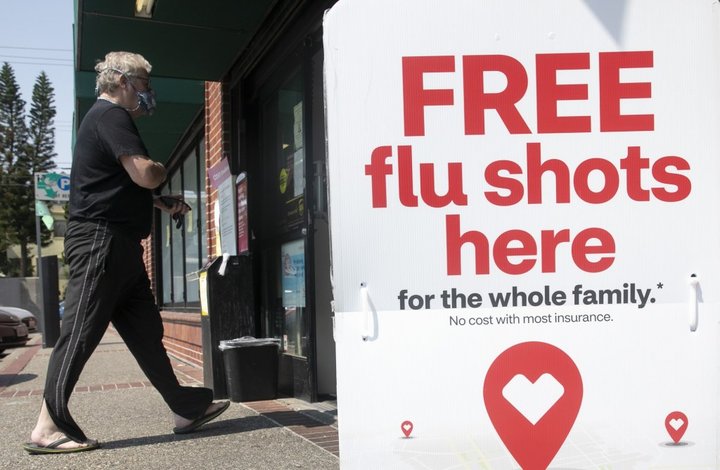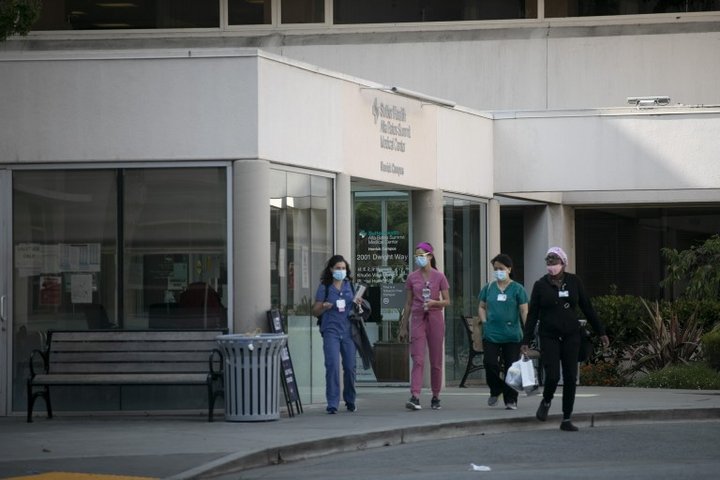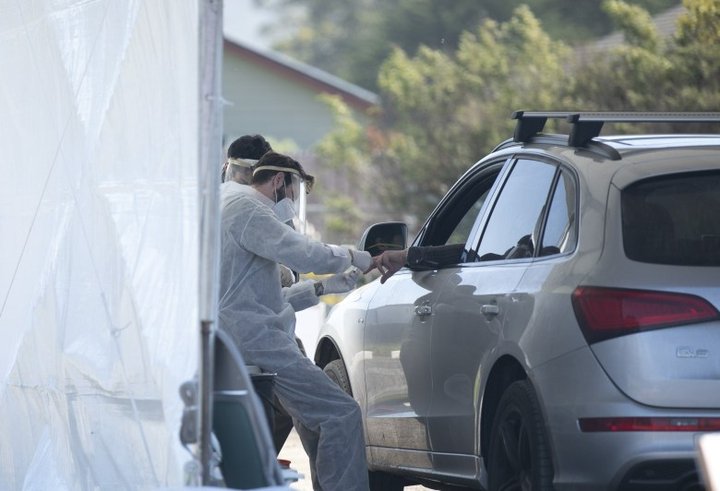
A billboard encouraging drivers to wear a mask posted along I-80 outside of Vacaville on Aug. 28, 2020. Photo by Anne Wernikoff for CalMatters
###
In the border county of Imperial, health officials are sharing a promising progress report: After being branded a hot spot, coronavirus hospitalizations are down. Sick patients are no longer being transferred out of county. Businesses are reopening.
“It’s absolutely fantastic,” said Adolphe Edward, the CEO of El Centro Regional Medical Center, one of the two hospitals in Imperial County.
But as fall approaches, Edward fears this taste of relief will be brief. For months, health experts have warned about a possible spike in coronavirus cases and hospitalizations for the fall and winter months, when colder weather will drive people indoors and holidays will likely bring friends and extended families together. That, on top of the impending flu season, could create what Gov. Gavin Newsom and others have referred to as a “twindemic.”
Doctors and public health officials across the state are echoing this message. A combination of COVID-19 and influenza could put serious pressure on a health care system that is only starting to stabilize after a summer of peaks in hospitalizations and admissions to intensive care units.
“Things can get very bad,” said Dr. George Rutherford, an epidemiologist at the University of California, San Francisco. “The concern is if there is a bad flu season, emergency rooms will get full and saturate capacity much more quickly.”
There is a glimmer of hope, though. Hospital and state officials say they are better prepared for a possible second wave of COVID, and can draw from the lessons learned during these past six months. Hospitals have refined their surge plans, and the state has come out with a plan to significantly increase testing capacity starting in November. Supply-chain constraints for coveted protective gear have also relaxed some.
Still, the toll of COVID plus the flu will depend largely on people’s behavior, Edward said.
“We can all dream and hope, but nobody knows for sure what we’re going to see,” he said.
Here, though, is a glimpse of what lies ahead:
Flu shots, flu shots, flu shots

A sign advertising free flu shots posted outside of CVS in Piedmont on Sept. 2, 2020. Photo by Anne Wernikoff for CalMatters
A reminder: While there is no vaccine ready yet to fight off coronavirus, the flu is preventable. Oh, and also, people can get both at the same time.
In a best case scenario, Californians largely heed to public health recommendations, get their flu shots, and contribute to a mild flu season. Rutherford pointed to countries in the Southern Hemisphere, like Australia, where flu season usually peaks in August. In late August, Australian health officials reported that flu activity there was “lower than average” for that time of year.
This could be because this year’s vaccine was a good match to flu strains, or perhaps people are still taking protective measures against COVID-19, such as wearing masks and socially distancing, Rutherford said. Precautions can protect against both illnesses.
In a worst case scenario, high flu activity in California coincides with another coronavirus surge. On Wednesday, Riverside County health officials reported that a man in his 80s who died last week is the county’s first flu death of the season.
In the 2017-18 flu season, considered “severe” by the Centers for Disease Control and Prevention, the agency recorded 810,000 influenza-related hospitalizations nationwide. Dr. Mark Ghaly, the state’s health and human services secretary, said about 100,000 Californians were hospitalized that year and 7,500 died from the flu.
“The flu is not to be taken lightly,” Ghaly said.
Still, less than half of adults in the U.S. receive flu shots each year, according to the Centers for Disease Control and Prevention.
Besides delivering more aggressive messaging on the importance of flu vaccines, Ghaly said in a recent press call that the state is working with health systems to increase the number of sites available for flu vaccinations. It is also working to ensure there will be enough supply, he said.
Vaccine makers say they are confident they’ll meet the demand. Pharmaceutical giant Sanofi, one of the largest manufacturers of influenza vaccines, for example, will be distributing 80 million doses in the U.S. this year. That’s a 15% increase from last flu season and the largest volume ever, said Chris Whitman, head of influenza franchise at Sanofi in North America. Overall, the CDC estimates vaccine makers will supply between 194 million and 198 million doses.
Also, getting a flu shot this year may look a little different.
Rather than waiting in long lines for a flu shot, providers, such as Kaiser Permanente, are offering drive-up and walk-up appointments. And patients who are already visiting their doctor for any other reason, will be encouraged to get their shot right then and there, said Dr. Vivian Reyes, Kaiser’s regional medical director of hospital operations in Northern California.
Reyes recommends that people get the influenza vaccine as soon as possible. “We never know when exactly flu season will hit,” Reyes said. “Starting early will allow us to vaccinate more people.”
The CDC recommends that people be vaccinated for influenza by the end of October.
Hospitals prepare for Round 2…or is it 3?

Hospital employees leave Alta Bates Hospital in Berkeley on August 24, 2020. Photo by Anne Wernikoff for CalMatters
California is headed into the fall with declining trend lines: the rate of people who test positive for coronavirus is down, and hospitalizations have been dropping consistently since a July 21 peak.
But depending on whom you ask, a fall surge in California would either be a continuation of this first wave (because while declining, numbers still aren’t low enough) — or a second wave. By some accounts, the state could be headed for a third wave (if you split the spring and summer peaks).
Still, whatever wave the state is on, hospitals now have a better idea of how to be ready.
Edward in Imperial, a rural county of about 180,000, said his hospital now has access to temporary staff it can draw from if needed. That’s a big help, he said, because bed availability is not only about the physical space, but having the right medical professionals on hand. He’s also acquired a number of higher grade ventilators, so that his hospital will rely less on borrowing equipment from the state, he said.
But if his hospital again started to see the volume of patients it saw earlier this year, he still doesn’t think it would be able to take them all. In May, Imperial County began to see more COVID-19 patients than its hospitals could handle. By the July 4 weekend, the county had transferred 526 patients to hospitals in counties as far away as Sacramento.
And having to transfer ill patients outside county lines becomes a challenge when other regions’ resources are also stretched thin. “I don’t think we should rely on that,” he said. He said his hospital continues to work with the state’s emergency medical services agency to come up with alternatives.
“What’s different now than March and April is that staff who have been at the forefront now for months, they are exhausted.”
— Carmela Coyle, CEO of the California Hospital Association
Meanwhile, Dr. Reyes at Kaiser Permanente said the organization’s 21 hospitals in Northern California usually have around 2,800 patients in beds at any time. During flu season, this number jumps to around 3,000. This year, because of the overlay of coronavirus and the flu, the system is preparing to take 5,000 patients.
As a large system, Kaiser can also move staff around from one hospital to another, as needed, to cover hot spots, Reyes said. But not all hospitals have the same fallback.
For some hospitals, one worry is staff burnout, said Carmela Coyle, president and CEO of the California Hospital Association.
“What’s different now than March and April is that staff who have been at the forefront now for months, they are exhausted,” Coyle said. Plus, some nurses and other staff who are parents with children doing distance learning at home have had to cut their hours or rearrange their schedules.
And, because symptoms for the flu and COVID are so similar, Coyle said, staff will initially need to assume sick patients coming in have COVID and be geared up. This means going through hospitals’ precious N95 respirators, face shields and other protective equipment much quicker, she said.
After months of struggling with supply chain shortages, Newsom announced in July that the state would keep a stockpile of 100 million N95 respirators and 200 million surgical masks for the fall. That’s to be shared among schools, agricultural workers, nursing home workers and other essential employees.
Hospitals have their own contracts and supply sources for PPE but can access the state stockpile if they can show immediate need, Coyle said.
Testing 2.0

A phlebotomist takes a finger prick blood sample at a drive-through COVID-19 testing site in Bolinas on April 22, 2020. Bolinas was attempting to test the entire town in conjunction with a UCSF study, one of the first efforts of its kind in California. Photo by Anne Wernikoff for CalMatters.
Just in time for fall, Newsom last week announced a deal with a diagnostics company that will allow the state to more than double its testing capacity.
Starting in November, the state will start working toward a goal of 150,000 additional tests, with turnaround times of 24 to 48 hours — a significant improvement from the current average wait of five to seven days. Once fully implemented, California’s new deal is supposed to allow for up to a quarter of a million tests each day.
More testing means more access for everybody. And quicker turnaround times will allow for improved contact tracing and isolation of infected individuals, which is considered key to reopening the economy.
“Flu season, of course, puts tremendous stress and demand for testing,” Newsom said in a press briefing last week. “People that develop flu-like symptoms are going to understandably and likely request that they get tested not only for flu, but also get tested for COVID-19.”
This week, the state also announced that it would be developing a new COVID-19 data reporting system to support the demand in testing that’s expected to come.
The state recently had to work through a severe backlog of test records as a result of glitches in the current electronic reporting system that couldn’t handle the volume of data. The new system is expected to be up and running by October.
Testing has been one of the biggest hurdles for California and the country during the pandemic. With testing supplies short from the get-go, it was months before California began processing about 100,000 tests a day, but by some estimates, still not enough.
Scientists at the Harvard Global Health Institute, for example, have estimated that California should be doing upward of 220,000 tests a day to truly mitigate spread of the virus, and significantly more to suppress it.
To add to the difficulties, California is also currently fighting off some of the largest wildfires in state history that have prompted some testing centers in affected areas to temporarily close driving down the number of tests done per day.
Will schools ride the second wave?
The promised improvements in testing is good news for schools.
The vast majority of California’s public and private schools have started off the year with remote learning, but as counties begin to see virus transmission go down, they may choose to reopen schools.
School districts can currently seek permission from their county and the state to reopen K-6 schools, as long as they meet certain criteria. And based on the state’s new reopening blueprint, schools in some large counties, such as Orange County, are on track to be allowed to reopen later this month.
Health experts say the fall, though, will be a tricky time to send kids to school, when sniffles, coughs and sneezes are already common. Children have been mostly spared from the pandemic, although there has been concern over a rare but serious multisystem inflammatory syndrome connected to coronavirus infections in kids.
The big worry is that children and teens will bring the disease back to parents and grandparents, who are more vulnerable to falling severely ill.
“[Coronavirus] is a result of not having a vaccine available, but we do have a flu vaccine. So we’re pushing that really hard.”
Sheri Coburn, san joaquin county school nurse
Rutherford, the UCSF epidemiologist, said another surge could be triggered by 12- to 22-year-olds if schools and colleges reopen. “Masks are not part of their wardrobe and socially distancing is not part of the equation,” he said.
Rutherford also points to universities in other states, like Michigan State and Notre Dame, where restarting in-person instruction was quickly followed by outbreaks, forcing them to shut back down.
On Sunday, just one week into the new school year, Chico State canceled its limited number of in-person classes after nearly 30 people tested positive for COVID.
Ideally, testing would improve to the point where schools could routinely and easily mass-test students the way professional sports teams can test their athletes, Rutherford said.
“It’s not science fiction, it’s just a question of availability and funding,” he said.
For now, some schools are passing along the flu shot message.
Sheri Coburn, a school nurse in San Joaquin County and past president of the California School Nurses Organization, said she is calling the parents of students who may be medically vulnerable to make sure they are up to date on their immunizations and medications.
Coronavirus “is a result of not having a vaccine available, but we do have a flu vaccine,” Coburn said. “So we’re pushing that really hard.”
###
CalMatters COVID-19 coverage, translation and distribution is supported by generous grants from the Blue Shield of California Foundation, the California Wellness Foundation and the California Health Care Foundation. CALmatters.org is a nonprofit, nonpartisan media venture explaining California policies and politics.
CLICK TO MANAGE